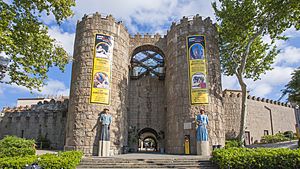Poble Espanyol facts for kids

Gate of Avila replica
|
|
| Established | 1929 |
|---|---|
| Location | Avda. Francesc Ferrer i Guardia, 13, Barcelona, Spain |
| Type | Architectural Museum |
| Architect |
|
The Poble Espanyol (pronounced POH-bleh Es-pan-YOL) means 'Spanish town' in Catalan. It's a special outdoor museum in Barcelona, Catalonia, Spain. Imagine a whole village built with copies of famous buildings from all over Spain! It's about 400 meters from the beautiful Fountains of Montjuïc.
This unique place was created for a big event called the 1929 Barcelona International Exposition back in 1929. It has 117 full-sized buildings that look just like the originals. These buildings are put together to make a small town, showing off different styles of Spanish architecture. You can also find a theater, restaurants, shops where artists make things, and a museum of contemporary art (modern art) here.
History of Poble Espanyol
Why it was Built
The Poble Espanyol was built for the 1929 Barcelona International Exposition. This was a huge international fair held in Barcelona. The idea was to show off the amazing buildings and town designs from different parts of Spain. It was like creating a mini-Spain in one place!
Who Designed It
The idea for Poble Espanyol came from a famous Catalan architect named Puig i Cadafalch. The actual design and building work were done by two architects, Francesc Folguera and Ramon Reventós. They worked with an art critic named Miquel Utrillo and a painter named Xavier Nogués.
These four experts traveled all over Spain. They visited more than 600 different places! Their goal was to find the best examples of traditional Spanish buildings. They wanted to combine these examples to create one "Spanish town."
A Mix of Styles
Even though they tried to create one "Spanish" style, the Poble Espanyol actually shows how many different kinds of buildings and designs there are in Spain. Spain has many different regions and cultures. Because of this, there isn't just one single "Spanish" building style. The Poble Espanyol celebrates this amazing variety!
See also
 In Spanish: Pueblo Español de Barcelona para niños
In Spanish: Pueblo Español de Barcelona para niños

